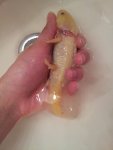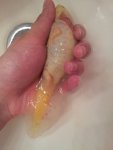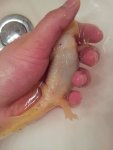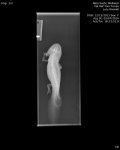Sylerwin
New member
Short version:
Female axolotl laid her first batch of eggs, only about 10 eggs, not viable. Stopped eating after laying eggs, tried many different foods. Separated from males. Gills began to pale. Water in normal range. Started swimming in spirals. Brought her to another axolotl owner to try and care for her. Since there, skin developed severe spotting.
Long version:
My female axolotl (9 months old, 8.5 in long) laid her first batch of eggs a few weeks back. There were only a couple of eggs, maybe around 10, and they ended up not being viable. After that she stopped eating. I tried nightcrawlers (full and cut), red wigglers, and bloodworms. Her gills began loosing color, and after a week of not eating I asked another axolotl owner to take her and try and treat her in case it was a water issue on my end. I tested water, it is all within normal range (ammonia 0ppm, nitrite 0ppm, nitrate 20ppm), temp 62F. My other axolotls in the tank are doing just fine. I use Prime as a water conditioner, and let water sit (with prime) for 24 hours in buckets before adding it to tank to let chlorine evaporate. Since she has been in the care of the other axolotl owner, her condition has worsened. Still no eating, laying on side or swimming in spirals. She uses Aquasafe conditioner, and is doing water changes daily (not sure how much, I'm assuming 100% because she said she picks her up to remove her). She tried fridging for 2 days, and indian almond leaves. No luck. Unfortunately she had a fungus hit all her axolotls including mine so she had to recover from that, too. When I first dropped her off she said she saw very slight red spots (I don't recall seeing them), but today they are really bad. I'll post some photos of what she sent me today. Any thoughts would be greatly appreciated, I'm out of ideas...
Female axolotl laid her first batch of eggs, only about 10 eggs, not viable. Stopped eating after laying eggs, tried many different foods. Separated from males. Gills began to pale. Water in normal range. Started swimming in spirals. Brought her to another axolotl owner to try and care for her. Since there, skin developed severe spotting.
Long version:
My female axolotl (9 months old, 8.5 in long) laid her first batch of eggs a few weeks back. There were only a couple of eggs, maybe around 10, and they ended up not being viable. After that she stopped eating. I tried nightcrawlers (full and cut), red wigglers, and bloodworms. Her gills began loosing color, and after a week of not eating I asked another axolotl owner to take her and try and treat her in case it was a water issue on my end. I tested water, it is all within normal range (ammonia 0ppm, nitrite 0ppm, nitrate 20ppm), temp 62F. My other axolotls in the tank are doing just fine. I use Prime as a water conditioner, and let water sit (with prime) for 24 hours in buckets before adding it to tank to let chlorine evaporate. Since she has been in the care of the other axolotl owner, her condition has worsened. Still no eating, laying on side or swimming in spirals. She uses Aquasafe conditioner, and is doing water changes daily (not sure how much, I'm assuming 100% because she said she picks her up to remove her). She tried fridging for 2 days, and indian almond leaves. No luck. Unfortunately she had a fungus hit all her axolotls including mine so she had to recover from that, too. When I first dropped her off she said she saw very slight red spots (I don't recall seeing them), but today they are really bad. I'll post some photos of what she sent me today. Any thoughts would be greatly appreciated, I'm out of ideas...






